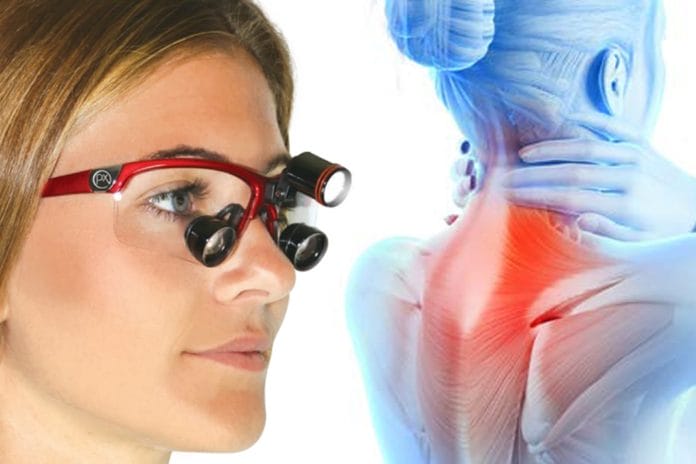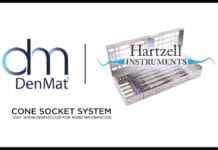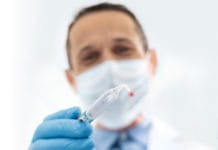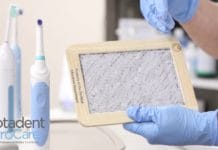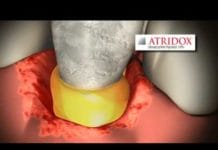Test Your Loupes & Ergonomic Knowledge
Disclosure: This quiz is sponsored content from DenMat as part of our sponsored partner program.
Musculoskeletal disorders (MSDs) are most common when tasks require fine repetitive movements and prolonged static positions. To decrease risk factors of MSDs for dental professionals, it is suggested to maintain neutral body positioning, use magnification loupes, and improve work pacing.
It is well-known that clinical dental practice creates excess physical stress on clinicians and is considered an occupational risk factor. Some of the most common occupational hazards dental hygienists face are musculoskeletal disorders (MSDs) which occur when tasks require fine repetitive movements and prolonged static positions. Though researchers have a difficult time finding the precise musculoskeletal etiologies and appropriate preventive strategies to reduce MSDs, it is suggested that maintaining neutral body positions, using magnification loupes, and improving work pacing may be integral in decreasing risk factors for dental hygienists.
Ludwig E.A., McCombs G.B., Tolle S.L., Russell D.M., (2017). The Effect of Magnification Loupes on Dental Hygienists’ Posture while Exploring. Journal of Dental Hygiene. 91(4):46-52. Retrieved from http://jdh.adha.org/content/91/4/46
A dental practitioner’s successful application of ergonomics includes which of the following:
Dental practitioners commonly face ergonomic challenges in their work environments and may wish to take action and make improvements. The level of risk associated with ergonomic challenges depends on the intensity, frequency, and duration of prolonged awkward postures. Though preventing work-related musculoskeletal disorders is commonly thought of when referring to ergonomics challenges, the successful application of ergonomics also includes increased career satisfaction, high productivity levels, and avoidance of illnesses and injuries.
Gupta A., Bhat M., Mohammed T., Bansal N., Gupta G., Ergonomics in Dentistry. Int J Clin Pediatr Dent. 2014;7(1):30-34. Retrieved from https://www.ncbi.nlm.nih.gov/pmc/articles/PMC4144062/
Which of the following types of technology is the newest to be used in dental headlights?
Along with magnification loupes, coaxial illumination (aka headlights), offers many ergonomic benefits, especially when used in tandem with magnification loupes. Coaxial illumination was first used by surgeons in the 1980s. Since then, dental headlights have used an array of technologies, including fiber optic lights, halogen lights, and xenon lights. The newest illumination technology, light emitting diode (LED), has many beneficial qualities including small size, minimal creation of heat, and extremely long-lasting.
Holt E.R., Hoebeke R., (2012). Shine a Light. Dimensions of Dental Hygiene. 10(9):25-27. Retrieved from https://dimensionsofdentalhygiene.com/article/shine-a-light/
Even though proper working distance and declination angles are important when purchasing loupes, loupes have a universal fit, and thus there is no need for them to be custom fitted to the clinician.
When fitted properly to a clinician, loupes magnify the working area and have the potential to promote neutral body position. Due to individual differences with working distances and declination angles, it is important to seek professional guidance and for each clinician to be properly fitted. Customizations and personal preferences include working distance, depth of field, frame weight and size, and optical declination angle.
Ludwig E.A., McCombs G.B., Tolle S.L., Russell D.M., (2017). The Effect of Magnification Loupes on Dental Hygienists’ Posture while Exploring. Journal of Dental Hygiene. 91(4):46-52. Retrieved from http://jdh.adha.org/content/91/4/46
Loupes are the latest in magnification devices that have been used in dentistry to bridge the gap between the naked eye and the microscope. Which of the following has not been used as a magnification device in dentistry?
Throughout history, dental professionals have relied on magnification devices for visual enhancement of dental procedures and anatomy in the oral cavity. With long hours spent in narrow operating spaces, and with natural vision beginning to deteriorate at the average age of 40, it is imperative for dental professionals to have proper tools to bridge the gap between the naked eye and the microscope. Over the years these tools have included the use of endoscopes, magnifying glasses, intraoral cameras, as well as magnification loupes.
Low J.F., Dom T.N.M., Baharin S.A., (2018). Magnification in endodontics: A review of its application and acceptance among dental practitioners. Eur J Dent. 12(4):610-616. Retrieved from https://www.ncbi.nlm.nih.gov/pmc/articles/PMC6178675/

